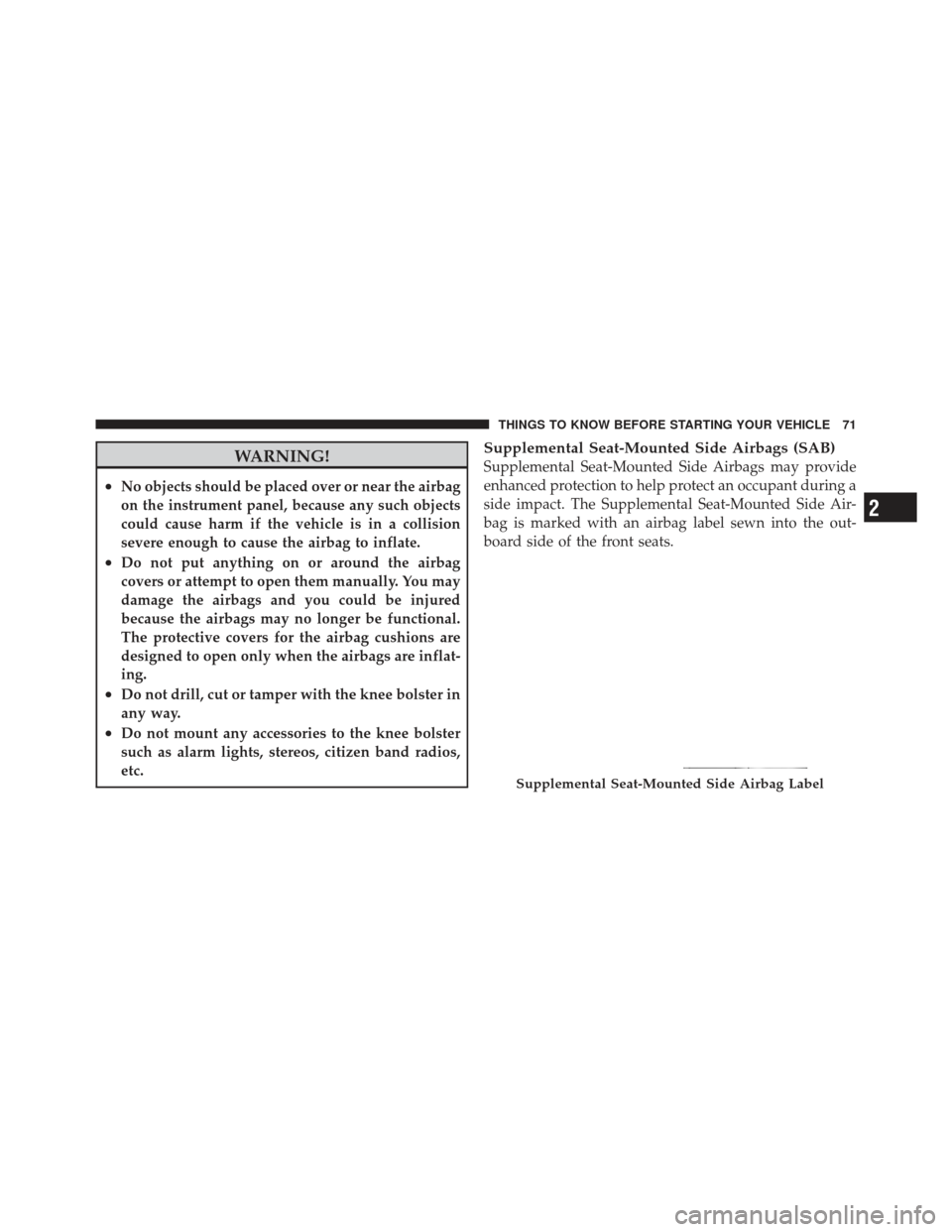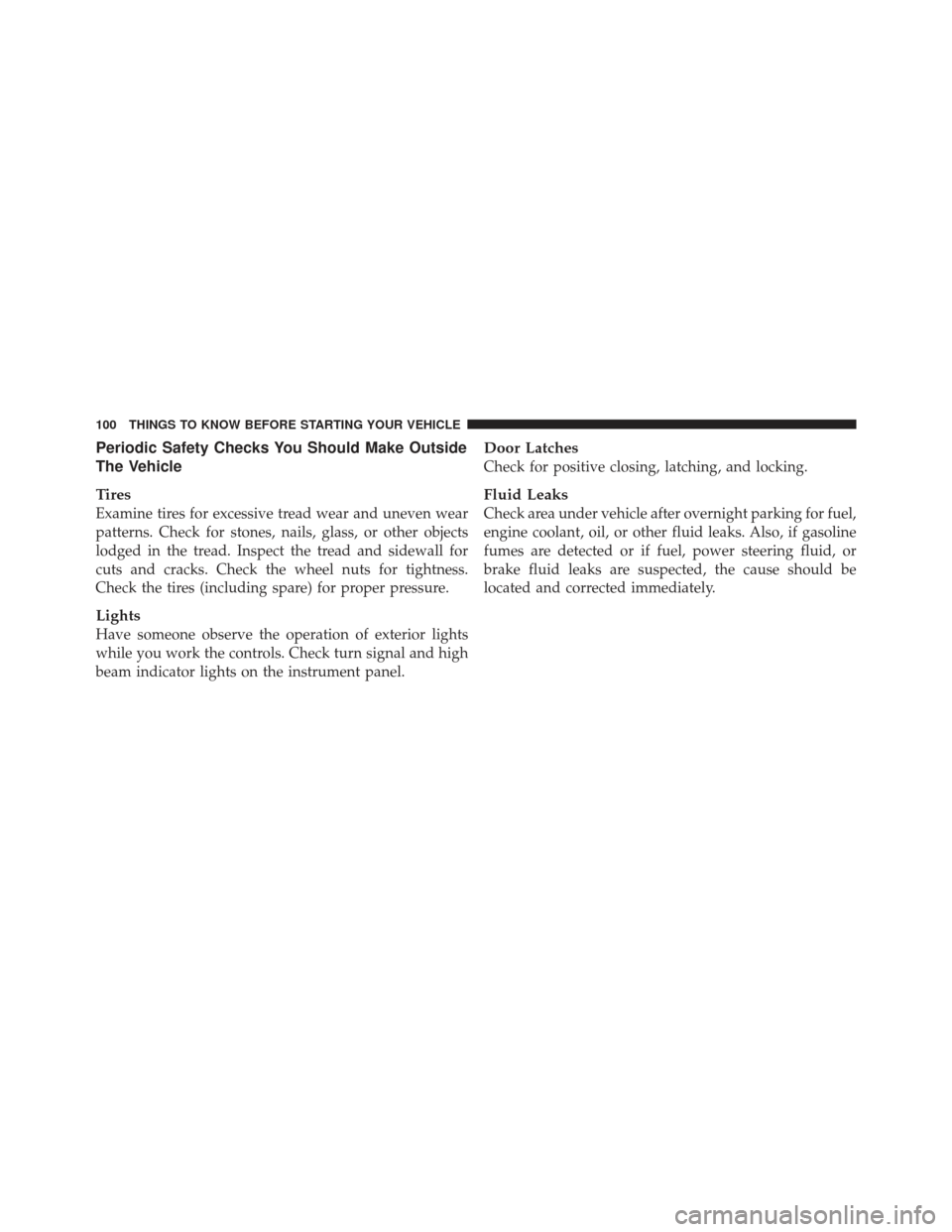2011 JEEP GRAND CHEROKEE lights
[x] Cancel search: lightsPage 23 of 587

•This device must accept any interference that may be
received, including interference that may cause unde-
sired operation.
VEHICLE SECURITY ALARM — IF EQUIPPED
This Vehicle Security Alarm monitors the vehicle doors,
liftgate, liftgate flipper glass, and ignition for unauthor-
ized operation. When the alarm is activated, the interior
switches for door locks, power liftgate and flipper glass
are disabled. The Vehicle Security Alarm provides both
audio and visual signals, the horn will sound, the head-
lights, park lamps and/or turn signals will flash repeat-
edly for three minutes. If the disturbance is still present
(driver’s door, passenger door, other doors, ignition) after
three minutes, the headlights, park lamps and/or turn
signals will flash for an additional 15 minutes.
NOTE:The Panic and Security alarms are quite differ-
ent. Please take a moment to activate the Panic and the
Security modes to hear the differences in the horn. In case one should go off in the future, you will need to know
which mode has been activated in order to deactivate it.
Rearming The System
If something triggers the alarm, and no action is taken to
disarm it, the Vehicle Security Alarm will turn off the
horn after three minutes, turn off all of the visual signals
after 15 minutes, and then the Vehicle Security Alarm will
rearm itself.
To Arm The System
Vehicles Not Equipped With Keyless Enter-N-Go
The alarm will set when you use the Remote Keyless
Entry (RKE) transmitter to lock the doors and liftgate, or
when you use the power door lock switch while the door
is open. After all the doors are locked and closed, the
Vehicle Security Light (located in the instrument cluster)
will flash rapidly for about 16 seconds to signal that the
Vehicle Security Alarm is arming. During this 16 second
arming period, opening any door or the liftgate will
2
THINGS TO KNOW BEFORE STARTING YOUR VEHICLE 21
Page 25 of 587

Vehicles Equipped With Keyless Enter-N-Go
Either press the UNLOCK button on the RKE transmitter,
pull on the front driver or passenger door handle (refer to
“Keyless Enter-N-Go” in “Things To Know Before Start-
ing Your Vehicle” for further information) with a valid
key fob in range, or press the Keyless Enter-N-Go Start/
Stop button (requires at least one valid Key Fob in the
vehicle), or insert a valid Key Fob into the ignition switch
(if the Start/Stop button is removed) and rotate it to the
ON/RUN position.
ILLUMINATED ENTRY
The interior lights come on when you open any door or
use the Remote Keyless Entry (RKE) transmitter to un-
lock any door. They will remain on for approximately
30 seconds after all doors are closed then fade to off.The lights also will fade to off if you turn on the ignition
after you close all the doors. Refer to “Electronic Vehicle
Information Center (EVIC)/Personal Settings (Customer-
Programmable Features)” in “Understanding Your In-
strument Panel” for further information.
NOTE:
None of the courtesy lights will operate if the
dimmer control is in the “defeat” position (extreme
downward position), unless the overhead map/reading
lights are turned on manually.
REMOTE KEYLESS ENTRY (RKE)
This system allows you to lock or unlock the doors and
liftgate, or activate the panic alarm, from distances up to
approximately 66 ft (20 m) using a hand-held Key Fob
with RKE transmitter. The RKE transmitter does not need
to be pointed at the vehicle to activate the system.
2
THINGS TO KNOW BEFORE STARTING YOUR VEHICLE 23
Page 27 of 587

Flash Lamps With Remote Key Lock
This feature will cause the turn signal lamps to flash
when the doors are locked or unlocked with the RKE
transmitter. This feature can be turned on or off. To
change the current setting, refer to “Electronic Vehicle
Information Center (EVIC)/Personal Settings (Customer-
Programmable Features)” in “Understanding Your In-
strument Panel” for further information.
Turn Headlights On With Remote Key Unlock
This feature activates the headlights for up to 90 seconds
when the doors are unlocked with the RKE transmitter.
The time for this feature is programmable on vehicles
equipped with the Electronic Vehicle Information Center
(EVIC). Refer to “Electronic Vehicle Information Center
(EVIC)/Personal Settings (Customer-Programmable Fea-
tures)” in “Understanding Your Instrument Panel” for
further information.
To Lock The Doors
Press and release the LOCK button on the RKE transmit-
ter to lock all doors. The turn signal lamps will flash and
the horn will chirp to acknowledge the signal.
Refer to “Keyless Enter-N-Go” under “Things To Know
Before Starting Your Vehicle” for further information.
Sound Horn With Remote Key Lock
This feature will cause the horn to chirp when the doors
are locked with the RKE transmitter or the Passive Entry
feature. The horn chirp feature can be turned on or off. To
change the current setting, refer to “Electronic Vehicle
Information Center (EVIC)/Personal Settings (Customer-
Programmable Features)” in “Understanding Your In-
strument Panel” for further information.
Remote Open Window Feature — If Equipped
This feature allows you to remotely lower both front door
windows at the same time. To use this feature, press and
release the UNLOCK button on the RKE transmitter and
2
THINGS TO KNOW BEFORE STARTING YOUR VEHICLE 25
Page 28 of 587

then immediately press and hold the UNLOCK button
until the windows lower to the level desired or until they
lower completely.
Using The Panic Alarm
To turn the Panic Alarm feature on or off, press and hold
the PANIC button on the RKE transmitter for at least one
second and release. When the Panic Alarm is on, the
headlights and park lamps will flash, the horn will pulse
on and off, and the interior lights will turn on.
The Panic Alarm will stay on for three minutes unless
you turn it off by either pressing the PANIC button a
second time, or drive the vehicle at a speed of 15 mph
(24 km/h) or greater.
NOTE:The interior lights will turn off if you turn the
ignition switch to the ACC or ON/RUN position while
the Panic Alarm is activated. However, the exterior lamps
and horn will remain on.
Programming Additional Transmitters
Programming Key Fobs or RKE transmitters may be
performed at an authorized dealer.
Transmitter Battery Replacement
The recommended replacement battery is one CR2032
battery.
NOTE:
•Perchlorate Material — special handling may apply.
See www.dtsc.ca.gov/hazardouswaste/perchlorate
•Do not touch the battery terminals that are on the back
housing or the printed circuit board.
26 THINGS TO KNOW BEFORE STARTING YOUR VEHICLE
Page 32 of 587

WARNING!
•Do not start or run an engine in a closed garage or
confined area. Exhaust gas contains Carbon Mon-
oxide (CO) which is odorless and colorless. Car-
bon Monoxide is poisonous and can cause serious
injury or death when inhaled.
•Keep Remote Keyless Entry (RKE) transmitters
away from children. Operation of the Remote Start
System, windows, door locks or other controls
could cause serious injury or death.
Remote Start Abort Message On Electronic Vehicle
Information Center (EVIC) — If Equipped
The following messages will display in the EVIC if the
vehicle fails to remote start or exits remote start prema-
turely:
•Remote Start Aborted — Door Ajar
•Remote Start Aborted — Hood Ajar
•Remote Start Aborted — Fuel Low
•Remote Start Aborted — System Fault
•Remote Start Disabled — Start Vehicle to Reset
The EVIC message stays active until the ignition is turned
to the ON/RUN position.
To Enter Remote Start Mode
Press and release the REMOTE START button
on the RKE transmitter twice, within five sec-
onds. The vehicle doors will lock, the parking
lights will flash and the horn will chirp twice (if
programmed). Then, the engine will start and the vehicle
will remain in the Remote Start mode for a 15 minute
cycle.
30 THINGS TO KNOW BEFORE STARTING YOUR VEHICLE
Page 73 of 587

WARNING!
•No objects should be placed over or near the airbag
on the instrument panel, because any such objects
could cause harm if the vehicle is in a collision
severe enough to cause the airbag to inflate.
•Do not put anything on or around the airbag
covers or attempt to open them manually. You may
damage the airbags and you could be injured
because the airbags may no longer be functional.
The protective covers for the airbag cushions are
designed to open only when the airbags are inflat-
ing.
•Do not drill, cut or tamper with the knee bolster in
any way.
•Do not mount any accessories to the knee bolster
such as alarm lights, stereos, citizen band radios,
etc.
Supplemental Seat-Mounted Side Airbags (SAB)
Supplemental Seat-Mounted Side Airbags may provide
enhanced protection to help protect an occupant during a
side impact. The Supplemental Seat-Mounted Side Air-
bag is marked with an airbag label sewn into the out-
board side of the front seats.
Supplemental Seat-Mounted Side Airbag Label
2
THINGS TO KNOW BEFORE STARTING YOUR VEHICLE 71
Page 80 of 587

Because airbag sensors estimate deceleration over time,
vehicle speed and damage are not good indicators of
whether or not an airbag should have deployed.
NOTE:In a rollover the pretensioners, SAB and/or
SABIC airbags may deploy on both sides of the vehicle.
Front And Side Impact Sensors
In front and side impacts, front and side impact sensors
can aid the ORC in determining the appropriate response
to certain impact events.
Enhanced Accident Response System
In the event of an impact causing airbag deployment, if
the communication network remains intact, and the
power remains intact, depending on the nature of the
event the ORC will determine whether to have the
Enhanced Accident Response System perform the follow-
ing functions:
•Cut off fuel to the engine.
•Flash hazard lights as long as the battery has power or
until the ignition key is turned off.
•Turn on the interior lights, which remain on as long as
the battery has power or until the ignition key is
removed.
•Unlock the doors automatically.
If A Deployment Occurs
The Advanced Front Airbags are designed to deflate
immediately after deployment.
NOTE: Front and/or side airbags will not deploy in all
collisions. This does not mean something is wrong with
the airbag system.
If you do have a collision which deploys the airbags, any
or all of the following may occur:
•The nylon airbag material may sometimes cause abra-
sions and/or skin reddening to the driver and front
78 THINGS TO KNOW BEFORE STARTING YOUR VEHICLE
Page 102 of 587

Periodic Safety Checks You Should Make Outside
The Vehicle
Tires
Examine tires for excessive tread wear and uneven wear
patterns. Check for stones, nails, glass, or other objects
lodged in the tread. Inspect the tread and sidewall for
cuts and cracks. Check the wheel nuts for tightness.
Check the tires (including spare) for proper pressure.
Lights
Have someone observe the operation of exterior lights
while you work the controls. Check turn signal and high
beam indicator lights on the instrument panel.
Door Latches
Check for positive closing, latching, and locking.
Fluid Leaks
Check area under vehicle after overnight parking for fuel,
engine coolant, oil, or other fluid leaks. Also, if gasoline
fumes are detected or if fuel, power steering fluid, or
brake fluid leaks are suspected, the cause should be
located and corrected immediately.
100 THINGS TO KNOW BEFORE STARTING YOUR VEHICLE